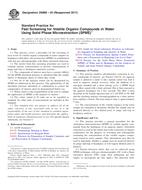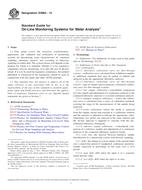Potrebujeme váš súhlas na využitie jednotlivých dát, aby sa vám okrem iného mohli ukazovať informácie týkajúce sa vašich záujmov. Súhlas udelíte kliknutím na tlačidlo „OK“.
ASTM D6889-03(2011)
Standard Practice for Fast Screening for Volatile Organic Compounds in Water Using Solid Phase Microextraction (SPME)
Automaticky preložený názov:
Štandardná prax pre rýchle skríningu prchavých organických zlúčenín vo vode Použitie pevnej fáze mikroextrakce (SPME)
NORMA vydaná dňa 1.5.2011
Informácie o norme:
Označenie normy: ASTM D6889-03(2011)
Poznámka: NEPLATNÁ
Dátum vydania normy: 1.5.2011
Kód tovaru: NS-36874
Počet strán: 5
Približná hmotnosť: 15 g (0.03 libier)
Krajina: Americká technická norma
Kategória: Technické normy ASTM
Kategórie - podobné normy:
Anotácia textu normy ASTM D6889-03(2011) :
Keywords:
screening , solid phase microextraction, SPME, volatile, water, Contamination--water, Fast screening, Flame ionization detectors (FID), Gas chromatography (GC)--water, Headspace analysis, Purge sampling, Screen analysis--water, Solid phase microextraction (SPME), Trace elements--water analysis, Trap sampling, Volatile organic compounds (VOC)--water, ICS Number Code 13.060.50 (Examination of water for chemical substances)
Doplňujúce informácie
| Significance and Use | ||||||||||||
|
This practice provides a general procedure for the solid-phase microextraction (SPME) of volatile organic compounds from the headspace of an aqueous matrix. Absorbent extraction is used as the initial step in the extraction of organic constituents for the purpose of screening and subsequently estimating the concentration of the volatile organic components found in water samples. This information may then be used to determine whether a sample may be analyzed directly by purge and trap or headspace or will require dilution prior to analysis. Typical detection limits that can be achieved using SPME techniques with gas chromatography (GC) with a flame ionization detector (FlD) range from milligrams per litre (mg/L) to micrograms per litre (μg/L). The detection limit, linear concentration range, and sensitivity of this test method for a specific organic compound will depend upon the aqueous matrix, the fiber phase, the sample temperature, sample volume, sample mixing, and the determinative technique employed. Solid phase microextraction has the advantage of speed, reproducibility, simplicity, no solvent, small sample size, and automation. Extraction devices vary from a manual SPME fiber holder to automated commercial devices specifically designed for SPME. A partial list of volatile organic compounds that can be screened by this practice is shown in Table 1. |
||||||||||||
| 1. Scope | ||||||||||||
|
1.1 This practice covers a procedure for the screening of trace levels of volatile organic compounds in water samples by headspace solid phase microextraction (SPME) in combination with fast gas chromatography with flame ionization detection. 1.2 The results from this screening procedure are used to estimate analyte concentrations to prevent contamination of purge and trap or headspace analytical systems. 1.3 The compounds of interest must have a greater affinity for the SPME absorbent polymer or adsorbent than the sample matrix or headspace phase in which they reside. 1.4 Not all of the analytes which can be determined by SPME are addressed in this practice. The applicability of the absorbent polymer, adsorbent or combination to extract the compound(s) of interest must be demonstrated before use. 1.5 Where used it is the responsibility of the user to validate the application of SPME to the analytes of interest. 1.6 The values stated in SI units are to be regarded as standard. No other units of measurement are included in this standard. 1.7 This standard does not purport to address all of the safety concerns, if any, associated with its use. It is the responsibility of the user of this standard to establish appropriate safety and health practices and determine the applicability of regulatory limitations prior to use. For specific hazard statements, see Section 9. |
||||||||||||
| 2. Referenced Documents | ||||||||||||
|
Podobné normy:
Historická
1.9.2012
Historická
1.10.2008
Historická
1.5.2011
Historická
1.6.2012
Historická
1.2.2009
Historická
1.9.2012
Odporúčame:
EviZak - všetky zákony vrátane ich evidencie na jednom mieste
Poskytovanie aktuálnych informácií o legislatívnych predpisoch vyhlásených v Zbierke zákonov od roku 1945.
Aktualizácia 2x v mesiaci !
Chcete vedieť viac informácii ? Pozrite sa na túto stránku.



 ASTM D3697-12
ASTM D3697-12 ASTM D3859-08
ASTM D3859-08 ASTM D3861-91(2011)..
ASTM D3861-91(2011).. ASTM D3864-12
ASTM D3864-12 ASTM D3865-09
ASTM D3865-09 ASTM D3866-12
ASTM D3866-12
 Cookies
Cookies
